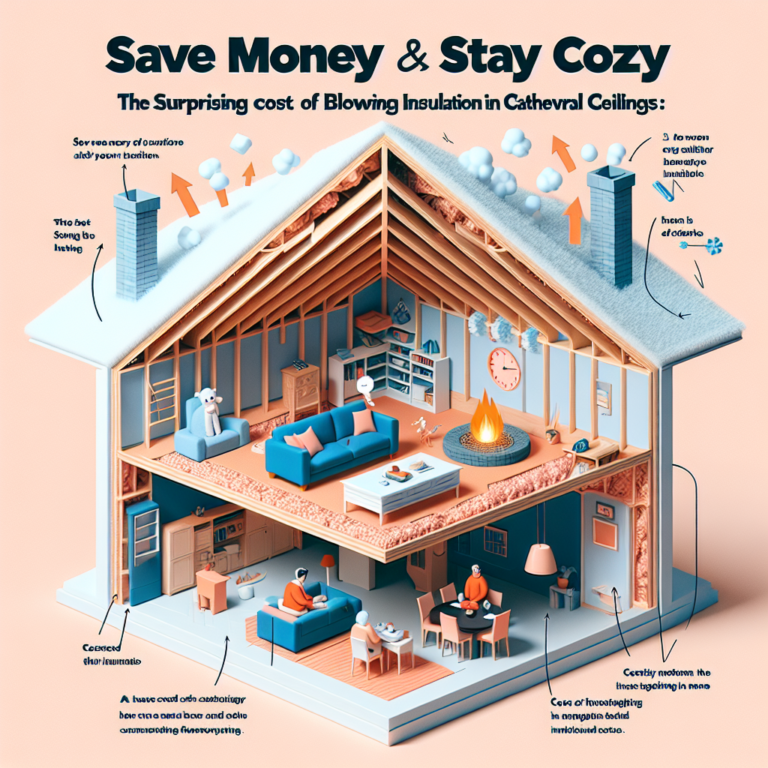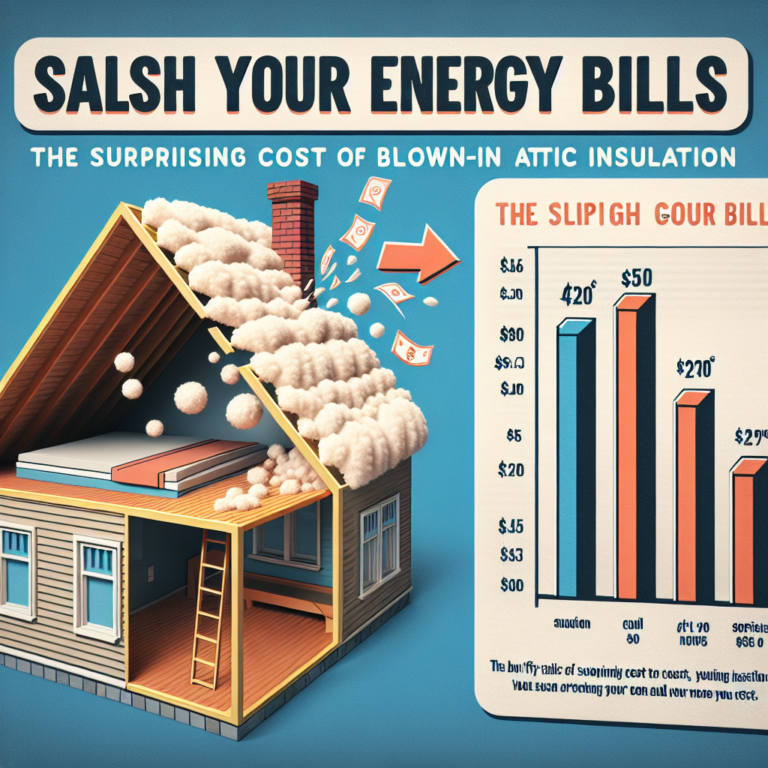-
Table of Contents
Save energy and money with proper blown-in insulation for your home.
“Upgrade your home’s energy efficiency with proper blown-in insulation. Visit texasinsulationsolution.com to learn more and schedule your installation today!”
Introduction
Energy-efficient homes are becoming increasingly popular as people look for ways to reduce their carbon footprint and save money on their energy bills. One key aspect of an energy-efficient home is proper blown-in insulation. This type of insulation is a cost-effective and environmentally friendly way to keep your home warm in the winter and cool in the summer. In this introduction, we will explore the benefits of proper blown-in insulation and how it can contribute to creating an energy-efficient home.
The Importance of Proper Insulation for Energy-Efficient Homes
Energy efficiency has become a top priority for homeowners in recent years. With rising energy costs and a growing concern for the environment, many people are looking for ways to reduce their energy consumption and save money on their utility bills. One of the most effective ways to achieve this is by ensuring that your home is properly insulated. And when it comes to insulation, blown-in insulation is the way to go.
Blown-in insulation, also known as loose-fill insulation, is a type of insulation that is installed by blowing or spraying it into place. It is made up of small particles of materials such as fiberglass, cellulose, or mineral wool. This type of insulation is highly effective in reducing heat loss and improving energy efficiency in homes.
One of the main benefits of blown-in insulation is its ability to fill in small gaps and crevices that other types of insulation may miss. This is especially important in older homes, where there may be gaps in the walls or attic that can let in drafts and cause energy loss. By filling in these gaps, blown-in insulation creates a more airtight seal, preventing heat from escaping and cold air from entering.
Proper insulation is crucial for energy-efficient homes. Without it, your heating and cooling systems have to work harder to maintain a comfortable temperature, resulting in higher energy bills. In fact, according to the U.S. Department of Energy, proper insulation can save homeowners up to 20% on their heating and cooling costs.
In addition to reducing energy costs, proper insulation also has a positive impact on the environment. By using less energy to heat and cool your home, you are reducing your carbon footprint and helping to combat climate change. This is especially important as the demand for energy continues to increase and our natural resources become more scarce.
When it comes to blown-in insulation, proper installation is key. It is important to hire a professional contractor who has experience with this type of insulation to ensure that it is installed correctly. Improper installation can lead to gaps and voids in the insulation, reducing its effectiveness and potentially causing other issues such as moisture buildup and mold growth.
Another factor to consider when choosing blown-in insulation is the R-value. The R-value is a measure of the insulation’s ability to resist heat flow. The higher the R-value, the more effective the insulation is at reducing heat loss. The R-value of blown-in insulation can vary depending on the material used, so it is important to consult with a professional to determine the best option for your home.
In addition to its energy-saving benefits, blown-in insulation also has other advantages. It is non-toxic and does not contain any harmful chemicals, making it a safe option for homes with children and pets. It is also resistant to pests and mold, providing a healthier living environment for you and your family.
In conclusion, proper insulation is essential for energy-efficient homes. Blown-in insulation is a highly effective option that can help reduce energy costs, improve indoor comfort, and have a positive impact on the environment. By hiring a professional contractor and choosing the right type and R-value for your home, you can ensure that your home is properly insulated and ready to withstand any weather conditions. So if you want to save money, reduce your carbon footprint, and create a more comfortable living space, consider blown-in insulation for your home.
How to Improve Home Efficiency with Blown-In Insulation
Energy efficiency has become a top priority for homeowners in recent years. With rising energy costs and a growing concern for the environment, many people are looking for ways to make their homes more energy-efficient. One of the most effective ways to achieve this is by properly insulating your home, and blown-in insulation is a popular choice for many homeowners.
Blown-in insulation, also known as loose-fill insulation, is made up of small particles of materials such as fiberglass, cellulose, or mineral wool. These particles are blown into the walls, attic, or other spaces in your home using a special machine. This method of insulation is highly effective in reducing heat loss and improving energy efficiency.
One of the main benefits of blown-in insulation is its ability to fill in small gaps and crevices that traditional insulation methods may miss. This creates a more airtight seal, preventing heat from escaping and cold air from entering your home. As a result, your home will require less energy to maintain a comfortable temperature, leading to lower energy bills.
Another advantage of blown-in insulation is its versatility. It can be used in various areas of your home, including walls, attics, and crawl spaces. This makes it an ideal choice for both new construction and existing homes. Additionally, blown-in insulation can be easily added to existing insulation, making it a cost-effective option for homeowners looking to improve their home’s energy efficiency.
Proper installation is crucial for the effectiveness of blown-in insulation. It is recommended to hire a professional insulation contractor who has experience with this type of insulation. They will have the necessary equipment and expertise to ensure that the insulation is evenly distributed and properly installed.
One of the key factors in achieving maximum energy efficiency with blown-in insulation is the R-value. The R-value is a measure of the insulation’s ability to resist heat flow. The higher the R-value, the more effective the insulation will be in reducing heat loss. The R-value of blown-in insulation can vary depending on the material used, so it is essential to consult with a professional to determine the best option for your home.
In addition to improving energy efficiency, blown-in insulation also offers other benefits. It can help reduce outside noise, making your home quieter and more comfortable. It also acts as a barrier against moisture, preventing mold and mildew growth, which can be harmful to your health and the structure of your home.
Furthermore, blown-in insulation is an environmentally friendly option. The materials used in blown-in insulation are often made from recycled materials, reducing the amount of waste in landfills. Additionally, the energy savings achieved through proper insulation can significantly reduce your carbon footprint.
In conclusion, blown-in insulation is an excellent choice for homeowners looking to improve their home’s energy efficiency. Its ability to fill in small gaps and its versatility make it a highly effective option. However, proper installation and consideration of the R-value are crucial for achieving maximum energy efficiency. By investing in blown-in insulation, not only will you save money on energy bills, but you will also contribute to a more sustainable future.
Benefits of Upgrading to Better Insulation for Energy-Efficient Homes
Energy efficiency has become a top priority for homeowners in recent years. With rising energy costs and a growing concern for the environment, many people are looking for ways to reduce their energy consumption and save money on their utility bills. One of the most effective ways to achieve this is by upgrading to better insulation for your home. Proper blown-in insulation can make a significant difference in the energy efficiency of your home, providing numerous benefits for both your wallet and the environment.
First and foremost, proper blown-in insulation can greatly reduce your energy bills. According to the U.S. Department of Energy, heating and cooling account for nearly half of the average household’s energy consumption. By properly insulating your home, you can significantly reduce the amount of energy needed to heat and cool your living space. This means that your heating and cooling systems will not have to work as hard, resulting in lower energy bills. In fact, studies have shown that homeowners can save up to 20% on their energy bills by upgrading to better insulation.
In addition to saving money, upgrading to better insulation can also increase the comfort of your home. Proper insulation helps to regulate the temperature inside your home, keeping it cooler in the summer and warmer in the winter. This means that you will no longer have to deal with drafty rooms or hot and cold spots throughout your home. With proper insulation, you can enjoy a consistently comfortable living space all year round.
But the benefits of upgrading to better insulation go beyond just saving money and increasing comfort. It also has a positive impact on the environment. By reducing your energy consumption, you are also reducing your carbon footprint. This means that you are doing your part to help combat climate change and protect the planet for future generations. In addition, proper insulation can also improve the air quality in your home. It acts as a barrier against outdoor pollutants, preventing them from entering your living space and improving the overall air quality inside your home.
Another advantage of blown-in insulation is its ability to reduce noise levels inside your home. Proper insulation can act as a sound barrier, reducing the amount of noise that enters your home from the outside. This is especially beneficial for those living in busy or noisy areas, as it can create a more peaceful and quiet living environment.
Furthermore, blown-in insulation is a cost-effective and efficient way to upgrade your home’s insulation. Unlike traditional insulation methods, such as batt or roll insulation, blown-in insulation can be easily installed in hard-to-reach areas, such as attics and crawl spaces. This means that every nook and cranny of your home can be properly insulated, ensuring maximum energy efficiency. Additionally, blown-in insulation is made from recycled materials, making it an environmentally friendly choice for homeowners.
In conclusion, upgrading to better insulation for your home is a wise investment that offers numerous benefits. From saving money on energy bills to increasing comfort and reducing your carbon footprint, proper blown-in insulation is a crucial step towards creating an energy-efficient home. So if you want to lower your energy bills, improve the comfort of your living space, and do your part for the environment, consider upgrading to better insulation for your home today.
Q&A
1. What is proper blown-in insulation?
Proper blown-in insulation is a type of insulation that is installed by blowing loose fibers or particles into the walls, attic, or other areas of a home. This method allows for a more even distribution of insulation and can fill small gaps and crevices that may be missed with traditional insulation methods.
2. How does proper blown-in insulation contribute to energy efficiency in homes?
Proper blown-in insulation helps to create a more airtight and well-insulated home, which can greatly reduce energy loss. This means that the home will require less energy to heat and cool, resulting in lower energy bills. It also helps to regulate the temperature in the home, making it more comfortable and reducing the need for constant heating or cooling.
3. Are there any other benefits to using proper blown-in insulation in homes?
Aside from energy efficiency, proper blown-in insulation also has other benefits. It can help to reduce outside noise, improve indoor air quality, and prevent moisture and mold growth. It is also a more environmentally friendly option as it is made from recycled materials and does not contain harmful chemicals. Additionally, it can increase the overall value of a home and make it more attractive to potential buyers.
Conclusion
In conclusion, proper blown-in insulation is a crucial factor in creating energy-efficient homes. It helps to reduce energy consumption and lower utility bills, while also providing a comfortable living environment. By properly insulating homes, we can reduce our carbon footprint and contribute to a more sustainable future. Investing in proper blown-in insulation is a smart choice for homeowners looking to save money and reduce their impact on the environment. With the increasing focus on energy efficiency, it is clear that proper blown-in insulation is an essential component of creating energy-efficient homes.






